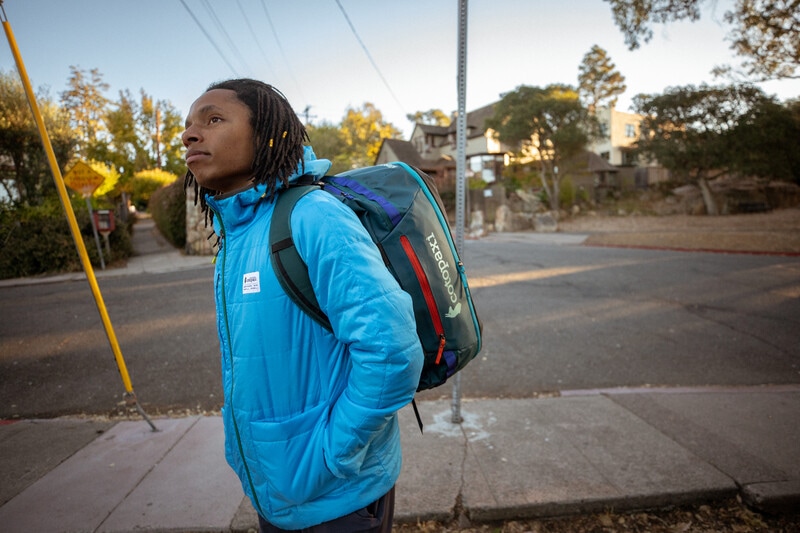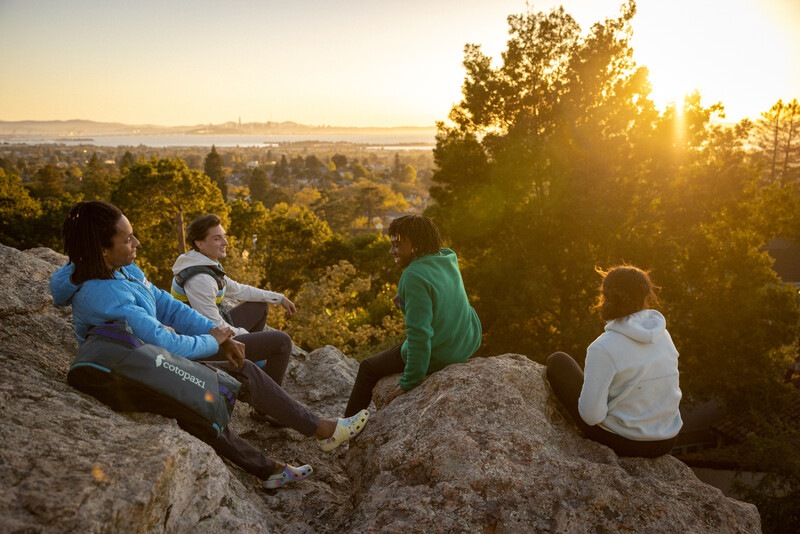When you think Cotopaxi, you probably think bright colors: blocks of pink and goldenrod, stripes of lime green. Maybe you even have Cotopaxi’s classic windbreaker hanging in your closet, its vivid hues and retro design a welcome contrast to your more understated outerwear. But Cotopaxi is also known for something else: doing good.
The Cotopaxi team has long understood the connection between people and planet: Studies have shown that our economic, social and emotional wellbeing is closely linked to the health and resilience of the natural world around us. That’s why the Utah-based brand has made a commitment to combatting poverty as well as to limiting the environmental footprint of its clothing production. But, you may be wondering: What does clothing production have to do with the planet? And how does that relate to ending poverty?
In this story, we examine these questions through the Teca Calido Hooded Jacket, part of the brand’s collection of layers and fleeces made from repurposed materials. We look at how the jacket is designed, what materials are used and, importantly, how all of this connects to helping impoverished communities. We also explore what it means for you as a consumer when you purchase from a brand that prioritizes people and the planet—because where you spend your dollar matters.
Using Upcycled Materials to Protect the Planet
The materials a brand uses can make a big impact on the environment. Producing synthetic fibers for the textile industry accounted for 1.35% of global oil consumption in 2021—that’s more than the annual oil consumption of Spain.
Fortunately, there are less resource-intensive ways to create clothes. For instance, by using recycled or remnant materials. For that reason, Cotopaxi aims to have every product comply with at least two of what its brand leaders call the three Rs—remnant, recycled and responsible—by 2025. It’s an effort to create new wears using materials already in circulation.

So, what do the three Rs mean to Cotopaxi designers? Let’s look first at recycled and remnant. You’re likely most familiar with the former: Recycled fabric is usually made from recycled yarn, which can come from a variety of sources, including plastic bottles and fishing nets, says Oriana Delgado, materials development manager at Cotopaxi. Remnant fabric, on the other hand, is material that was produced but was not used. Because most fabrics have a shelf life of between six months and a year (quality decreases over that time), that leftover fabric could ultimately end up in a landfill.
In the case of the Teca Calido Hooded Jacket, the outer layer is made from remnant taffeta while the inside includes 60 grams of recycled polyester insulation. The recycled insulation is what makes this jacket a solid weight for year-round activities like hiking and biking. By using recycled fabrics, Cotopaxi makes use of what’s already out there and helps reduce its reliance on creating more plastic, Delgado says. Using remnant fabric gives a use to material that could otherwise end up in landfills, which are a major source of climate-warming emissions.
Of course, there can be challenges to using recycled or remnant fabric, explains Annie Agle, senior director of impact and sustainability at Cotopaxi. For one, it takes extra time for Cotopaxi teams to coordinate with the factory on what available colors can be used. This can also limit designers to what’s available, which influences the design possibilities.
“When you’re using recycled, repurposed materials, you’re trying to design in a way that eliminates waste,” Agle says. “You don’t get to choose the fabric. You have to have the design fit the material and not the other way around.”
But this design approach is one of the driving missions behind Cotopaxi.
“Maybe at other companies it’s a nice-to-have but not a requirement,” says Julie Hirsch, category director of product at Cotopaxi. “For us, if we can’t deliver on the three Rs in a meaningful way, we won’t launch the product.”
So, how much less is your environmental footprint as a consumer when you purchase outerwear made from recycled or remnant materials? A 2017 study by the Federal Office for the Environment showed that recycled polyester could reduce emissions by up to 32% compared to virgin polyester. Cotopaxi has used 250,000 yards of remnant fabric for its Teca collection, keeping nearly a million yards of fabric from going to waste, according to its 2021 impact report. To put that in perspective: That much fabric could stretch more than 560 miles, or about twice the length of the Grand Canyon. So yeah, it’s a lot.
Furthermore, this insulated jacket is reversible, featuring the brand’s vibrant signature hues on one side and more muted tones on the other. You essentially get two styles from the jacket—one that appears bright on the trail, and another that pairs well with errand running in the city. This flexibility is by design: It provides options, so you can do more with a single jacket. And it’s at an approachable price point, says Ben Doxey, an apparel product designer at Cotopaxi.
The Intersection of Climate and Humanity
Protecting the environment is one piece of the larger Cotopaxi mission, which is to help lift communities out of poverty. Because yes, the two are intertwined: Climate change is a major contributor to global poverty
A warming climate can affect communities in many ways, such as by causing an increase in extreme weather events like hurricanes, wildfires and droughts. These disasters increase financial strain by causing destruction to homes and resources and contributing to food scarcity, among other things.

Another example can be seen in places like Latin America, Agle says. Because a warming climate has contributed to deforestation in this region—and thereby altered the environment—some countries have seen an increase in malaria-carrying mosquitoes. Malaria can contribute to poverty because it is an expensive ailment to treat, Agle explains. However, it’s affordable to prevent.
“Our mission has always been to end extreme poverty in our lifetime, but poverty obviously, like any issue … is multifaceted. It’s complex. It’s a moving target,” Agle explains. “We know that climate change is already really harming communities.”
What role does a jacket play in all of this? When a brand mitigates its use or production of planet-harming resources, it lessens its contribution to climate change. That’s why making a jacket from recycled materials matters—it’s making use of existing materials to prevent them from going to a landfill and to cut down on the resource-intensive process of making new stuff from scratch.
Additionally, each year, the brand allocates 1% of its revenue to its charitable arm, the Cotopaxi Foundation, which provides grants to nonprofits that help fight poverty around the globe. Those donations have a big impact. According to the brand’s impact report, Cotopaxi helped more than 1 million people in 2021.
So, the next time you pick up a Cotopaxi jacket, whether it’s the Teca Calido or the classic windbreaker, you’ll know that you’re making a decision beyond what will look cool on the trail. (Though you definitely will look cool on the trail.) You’re also supporting a broader mission to protect the planet and its people. You’re helping Cotopaxi do good by making good gear.

